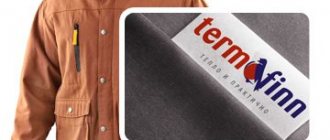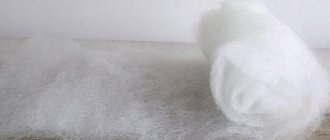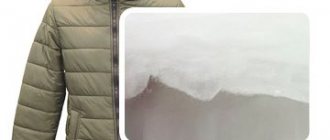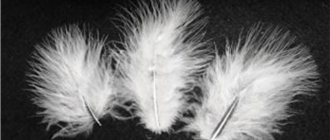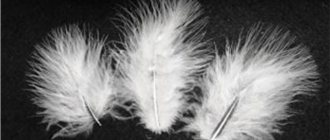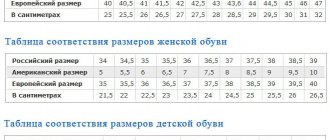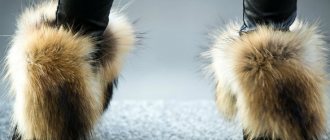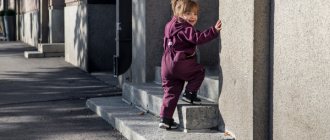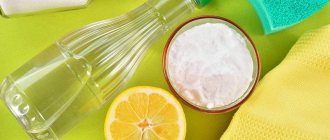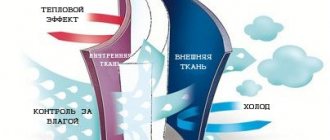Hello, my dear readers! Now we will figure out together what is best to sew outerwear from. This question especially begins to worry when the idea of sewing a children's jacket arises. After all, you won’t be able to check it yourself in a sock, test it.
How would you like to sew a winter or spring item and not worry about it later? Sewing for yourself is a little easier, but you still need to figure it out first.
All insulation materials are conventionally divided into natural (down, wool) and synthetic (sintepon, holofiber, isosoft, slimtex, thinsulate, etc.). Synthetic insulation is not allergenic, microorganisms do not grow in them, they hold their shape better than natural ones, retain heat well and do not let cold air in, and do not deform from washing. The material from which the insulation is made can be read on the jacket label. Most likely it will say “insulation - 100% polyester”, since any synthetic insulation consists of polyester fibers. It is not the insulation that warms, but the air in its cavities, and the lighter the insulation, the more cavities it has inside and the lower the temperature at which clothes with this insulation can be used. The volume of insulation determines what time of year and weather conditions the clothing is designed for: 40-70 g/sq.m. – from 0 to +10 100-150 g/sq.m. – from -5 to +5 200-300 g/sq.m. – from -20 to 0.
What is alpolux
Alpolux is a modern analogue of artificial down, competing with materials such as Thinsulate, Isosoft and Slimtex. This is an environmentally friendly product, which contains only primary processed raw materials, without foreign inclusions (crumbs, glass and other debris). To make Alpolux insulation, two components are required: natural sheep wool and microfiber. Depending on the required characteristics, the amount of wool ranges from 15 to 30%.
Manufacturing process
Alpolux artificial insulation is created using high-tech equipment.
Production stages:
- Sending raw materials to the conveyor;
- Heat treatment;
- Package.
On the conveyor line, wool pile and microfiber are mixed and then formed into a soft but resilient structure. The laser gauge shapes the edges, trimming off any excess. The finished strip of insulation resembles a mesh with microscopic cells. The special composition and combing system ensure that this fabric does not deform.
In the second stage, the material passes through heated rollers, sealing the top and bottom layers. This method of strengthening fibers is called calendering. Thanks to thermal bonding, insulation particles in the finished product do not migrate out through the upper fabric.
Spring-Autumn without insulation
This category includes parkas, jackets, raincoats, and bomber jackets with a light lining. The temperature regime for such models ranges from +5°C to +20°C.
The upper fabric is membrane, the lining is made of Polar Fleece.
Upper fabric: Cotton membrane purl. Lining: JERSEY.
Isosoft, thermofin, slidetex... How to understand the intricacies of winter clothing for a child
Partner news
Whether modern winter clothing suits them and how to dress a child so as not to go broke, we’ll find out together with the director of the children’s clothing store “Yula” Ekaterina Simikova .
Jumpsuit or set
Both options have their pros and cons.
+ The overalls are ideal for children from birth to one and a half to two years. Overalls are most often purchased for babies who are still walking in a stroller or are just starting to walk, as this option is easy to put on and retains heat better. Although many parents prefer overalls for older children.
+ Easy to put on and wear. With a slight movement of the hand, the mother, and then the child himself, unfastens and instantly takes off/puts on the overalls. There is no need to select a set or struggle with adjusting the straps for height and the waist for fullness. Put it on - and order!
+ Provides complete protection from snow and wind. The overalls do not ride up when skiing downhill, ensure a complete fit to the body due to the elastic waistband, and are often equipped with leggings, straps for fixing the trouser legs on shoes, windproof cuffs on the sleeves with a hole for the thumb and a windproof strip with a zipper.
— Overalls have two significant disadvantages. The first is that it cannot be bought “for growth” (with the exception of transformable overalls, which turn from an envelope into a full-fledged item of clothing). The second is that when entering a warm room (shopping center, queue at the hospital), the overalls are either removed entirely , or the child remains “packed” in hot outerwear.
This is interesting! Plastic thermometers sewn onto the side of the product will help you determine whether your child is hot or not.
+ The winter set is universal and economical. A dirty jacket or pants can be washed by temporarily combining it with another top or bottom. During a long car ride, a walk through the store, or waiting in a hospital line, parents simply take off the child’s jacket, leaving him in trousers or overalls. The set is the most convenient option for children from one and a half to two to primary school age. And if the child has outgrown the jacket, but the pants still fit, you can simply change the top. A variety of colors and styles, reflective elements, rubberized trouser cuffs, length adjustment of overalls and other modern trends in the finishing of outerwear make winter sets comfortable and practical.
By the way! When choosing overalls or bib overalls (pants with straps), pay attention to the presence of cordura - inserts made of dense fabric, which reinforce the most chafing areas of the product. For babies who are just starting to wean themselves off diapers, models with special material sewn into the trousers are suitable - it will protect them from leaks.
Insulation, lining and top
Upper fabric . If you are one of the advanced parents, then you know: modern winter clothes should be made of membrane fabric. But for this it is not at all necessary to look for sets or overalls exclusively promoted by Finnish ones; most of the winter clothing presented is made using a membrane. Despite the fact that we give priority to Russian and Belarusian manufacturers,” says Ekaterina Simikova, director of the Yula children’s clothing store. — Today, every serious factory has mastered the production of membrane fabric. On the label it can be hidden under the names Poly Pongee , Taslon Oxford , Taslon Nylon and others. The main thing is that, just like the Finnish versions, our membrane has water-repellent and windproof properties, while being able to transmit water vapor.”
Insulation . Grandmothers say: there is nothing warmer than natural materials! Sheepskin, down or down with feathers - this is what will best protect your child from the winter cold. But civilization is ahead of stereotypes. If the child can already move independently, clothing with artificial insulation would be the best option. They can be called differently: isosoft, holofiber, shelter, thermofin, sliteks, sliter. .. They have the same properties - excellent thermal insulation, lightness and ease of maintenance. “The use of natural insulation materials like down or sheepskin is no longer relevant in our time,” says E. Simikova. “Such models are much more expensive, heavier, and more difficult to maintain. They are much more allergenic than with artificial insulation.”
Lining . An additional source of warmth in winter clothes will be... the lining. Instead of slippery and smooth polyester, manufacturers are increasingly using warm soft fleece, cotton jersey or sheepskin-like faux fur. Basically, the back and sides of the products are covered with these materials, and the usual smooth lining is left in the sleeves to make it easier for the child to take off and put on clothes.
Which models to prefer
Director of the Yula children's clothing store Ekaterina Simikova: “Manufacturers are trying to make winter clothes that are as light, comfortable, warm, and most importantly functional as possible. This applies not only to the materials of the product, but also to their additional parts. I advise you to take a closer look at models that have an additional removable vest or jacket (made of fleece or faux fur), windproof cuffs or elastic cuffs on the sleeves. It’s good if the trouser legs are also equipped with elasticated cuffs.
It is optimal if the model has a detachable hood and a removable edge.
Useful information on insulation
For those who haven't tried everything yet
Copied on Osinka. I liked it very much. To get the full experience, I would like to touch everything myself, but you can visually understand what’s what).
DESCRIPTION OF INSULATIONS
Photo with flash
Photo without flash (the structure of the fibers is better visible here)
In the photo: from right to left and from top to bottom: 1. Pink pin - FLEXIFILL 100 2. Yellow pin - SLIMTEX 150 3. Red pin - TERMOFINN 150 4. Blue pin - TINSULEITE (P) 150 5. White pin - ALPOLUX 150 6 Pink pin - ISOSOFT (304) 150 7. Green pin - KLO-STAR 150 8. Yellow pin - REAL SOFT 150 9. Red pin - HOLLOFIBER SOFT 300
ISOSOFT insulation (Belgium)
ISOSOFT insulation (ISOSOFT) is a new generation of high-tech insulation produced by LIBELTEX (Belgium). It is used for the production of outerwear, children's, sports, work, workwear, as well as clothing for extreme conditions, bedding and sleeping bags.
ISOSOFT consists of various combinations of many finest fibers (fine-denier fibers), thanks to which it has unique heat-shielding properties with a small thickness of the fabric. ISOSOFT has a double-sided polymer coating that prevents fiber migration, which allows it to be used in combination with any fabric and makes the product suitable for a large number of washes.
ISOSOFT is distinguished by its extraordinary plasticity, softness, and high breathability. The insulation does not cause allergies and does not contain substances harmful to health (Products are certified according to the European standard Oeko-Tech 100 class 1) ISOSOFT insulation is much thinner than conventional padding polyester (1 layer of ISOSOFT replaces 4 layers of padding polyester), easily restores its shape after storage folded and retains it during long-term use.
ISOSOFT 304 Article densities g/m2 40 - 60 - 80 - 100 - 120 - 150 - 200 Fabric thickness mm 6 - 10 - 14 - 16 - 18 - 20 - 22
Care instructions:
- Machine washable at a temperature not exceeding 40°.
- Bleaching is prohibited.
- Do not wring or dry in a washing machine.
- Gentle cleaning based on perchlorethylene.
- Iron with an iron at minimum heat (corresponds to the symbols on irons).
Personal feelings. Soft, plastic, there is a thin “crust” (prevents fiber migration), the fluff inside is very soft to the touch, and when quilted, it flattens a little. Grade 304 is suitable for light fabrics, grade 34 is intended for thicker fabrics (it flattens less). In the photo - 6 on top with a pink pin.
Insulation TINSULATE (USA)
Thinsulate® was created by the American company 3M on behalf of NASA to sew clothing for astronauts. The task was to develop an ultra-thin and lightweight material Thinsulate® (from the English thin - thin, insulation - insulation) with thermal properties superior to natural down, wool and other synthetic insulation. The task was completed perfectly. This is how a material appeared that is now widely used for sewing both everyday and special clothing. Suffice it to say that the world's leading clothing manufacturers use Thinsulate® in their warmest products, US and Canadian special forces also use Thinsulate® for winter clothing, polar expeditions choose Thinsulate®. The material is used for the production of all types of clothing, shoes, gloves, hats and other accessories.
Thinsulate® type P insulation is a high-tech non-woven insulating material that combines increased thermal insulation properties with softness, low volume and weight of the fabric.
Insulation Thinsulate® type P Density of article g/m2 100 - 150 - 230 Thickness of fabric mm 10 - 13 - 21
One of the most effective insulation materials in terms of heat/weight ratio. It is easy to wash and dries quickly, retains its thermal insulation properties after dry cleaning. The colonized surface of the material provides freedom to use any fabric without the risk of fiber migration. Doesn't need quilting. The most economical of the Thinsulate® family of Hi-Tech insulation materials.
Purpose: children's clothing, casual and professional outerwear, gloves and haberdashery.
Sewing tips: Quilting can be done using regular quilting equipment. A quilting pitch of 11 to 25 cm is recommended for products quilted through and through. Care must be taken to ensure that the stitch pitch does not exceed the specified interval.
Care instructions:
- Machine washable at a temperature not exceeding 60°.
- Bleaching is prohibited.
- Dry at low temperature (gentle drying).
- Gentle cleaning based on perchlorethylene.
- Iron with an iron at minimum heat (corresponds to the symbols on irons).
Attention: Steam ironing is not allowed.
Personal feelings. Soft, plastic, there is a “crust” (prevents fiber migration), the inside of the fluff is soft and elastic, and when quilted it flattens a little. In the photo - 4 on top with a blue pin.
Insulation KLO-STAR (Finland)
Clo-Star™ - manufacturer SNT-Group, Finland. Used for outerwear, sportswear, workwear, leisure wear, gloves, hats, etc. Low densities of insulation are also recommended for use in small parts: in strips, pockets, valves.
Clo-Star™ is made from , a leader in synthetic raw materials. This is a hypoallergenic material that meets the OEKO-TEX 100 standard.
Clo-Star™ is elastic, soft, flexible and at the same time dense and compact material, convenient and technologically advanced in processing and production, pleasant and easy to use. The fabric consists of thermally bonded fibers, the weaving method of which makes the insulation resistant to various loads. It retains its thermal and volumetric characteristics after a large number of washes, has a higher tensile strength than other synthetic insulation materials and, thus, does not compromise the integrity of the thermal insulation fabric during wear and care. When clothing fabrics get wet, the fibers do not absorb moisture, which allows them to retain heat longer (compared to insulation made from natural fibers).
Clo-Star™ can be freely located between layers of fabric without “bumping” or shifting during use (does not require mandatory quilting), maintaining the appearance of clothing, resistant to creasing High heat-saving parameters, hypoallergenic, ability to “breathe”, no migration of fibers , unique recoverability and wear resistance give warmth, comfort, and long life to products with Clo-Star™ insulation.
Clo-Star™ has proven to be the most reliable synthetic insulation for areas with harsh winters. Actively used by clothing manufacturers in Scandinavian countries.
Article density g/m2 100 - 150 Fabric thickness mm 10 - 13
Care instructions:
- Machine washable at a temperature not exceeding 60°.
- Bleaching is prohibited.
- Dry at medium temperature (normal drying).
- Gentle cleaning based on perchlorethylene.
- Iron with an iron at minimum heat (corresponds to the symbols on irons).
Attention: Steam ironing is not allowed.
Personal feelings. Soft, plastic, there is a thin “crust” (prevents fiber migration), the fluff inside is of medium hardness, and practically does not flatten when quilted. In the photo - 7 on top with a green pin.
FLEXIFILL insulation (Finland)
Flexifill is a thin, soft insulation. Manufacturer: SNT-Group OY (Finland). Flexifill™ viscose insulation is designed for clothing made of fur, leather, drape and wool. Ideal as insulation for winter coats and fur coats, as it does not create volume.
Consists of viscose fibers (80%) and synthetic base (20%).
Traditionally used in the production of outerwear made from wool, leather and fur. Thanks to new developments, Flexifill can also be combined with thin outerwear fabrics.
When using Flexifill insulation, the natural shape of the product is preserved, there is no volume or rigidity, and the material does not become electrified.
Flexifill thickness is 1 - 1.5 mm.
Thanks to the base fabric, the material has good wind protection.
Clothes insulated with Flexifill have a beautiful appearance and good thermal insulation, despite their insignificant thickness.
Care instructions:
- Machine washable at a temperature not exceeding 40°.
- Perchlorethylene based cleaning.
Personal feelings. Super thin, soft, flexible. In the photo - 1 on top with a pink pin.
ALPOLUX insulation (Russia - using Austrian technology)
Alpolux® insulation is a product developed by the best Austrian experts, which is based on the European traditions of using wool for the manufacture of outerwear. Produced on high-quality German equipment.
A unique recipe for the production of a completely new product was developed especially for the Russian market - insulation, which perfectly combines the thermal insulation properties of natural wool and unique microfiber.
Easy to cut and holds its shape perfectly. Due to the fact that Alpolux insulation contains microfiber. It retains the elasticity of the insulation and keeps its shape. In addition, Alpolux products keep their shape perfectly, thanks to a special combing system (horizontal and vertical combing system) and calendering (a heat treatment process that avoids insulation migration).
Article density g/m2 100 - 150 - 200 Fabric thickness mm 8.2 - 13.1 - 16.2
Alpolux is an absolutely environmentally friendly product that is made only from primary raw materials. Primary raw materials do not contain impurities (e.g. broken glass, crumbs, dust, dirt) that are present in secondary raw materials, because This is the recycling of all kinds of garbage. Obtaining the Eco-Tex Standard 100 certificate, which is recognized throughout the world, confirmed the environmental friendliness and quality of Alpolux® insulation
Care instructions:
- Machine washable at medium temperature, gentle cycle.
- Dry at medium temperature (normal drying).
- Perchlorethylene based cleaning.
- Iron with an iron at minimum heat (corresponds to the symbols on irons).
Personal feelings. Fluffy, soft, flexible, there is a medium-density “crust” (prevents fiber migration), the inside of the fluff is soft and elastic, and does not flatten when quilted. Ideal for down jackets and padded jackets with quilting. In the photo - 5 on top with a white pin.
TERMOFINN insulation (Russia - using Finnish technology)
Termofinn® is a new product from the textile industry on the Russian market. This unique product is the result of a high-quality combination of Finnish technologies with domestic production using the latest European equipment.
Thanks to its unique composition of highly crimped and bicomponent fibers, as well as a specific processing temperature, termofinn is surprisingly warm. It is especially soft due to the absence of calendering (“crust”), but the fibers practically do not migrate due to the structure being highly crimped and thermally bonded at many points.
- Has a unique composition;
- Easy to cut and ideal for sewing;
- Very soft and very warm;
- Effective at low temperatures;
- Dries quickly;
- Retains its shape perfectly after washing;
- Eco-friendly and safe for children.
Article density g/m2 100 - 150 - 200 Fabric thickness mm 8.5 - 12.9 - 18.3
Termofinn® is the holder of the globally recognized international certificate Eco-Tex Standard 100 for the 1st product category. This means that it is recommended for sewing clothes for children and newborns.
Personal feelings. Soft, plastic, without a “crust”, the fluff is of medium hardness, and practically does not flatten when quilted. In the photo - 3 on top with a red pin.
REAL SOFT insulation (Russia) Calendered insulation, declared by the manufacturer as an analogue of holofiber. Unlike holofiber, it has a thermally bonded “crust” that prevents fiber migration.
Article density g/m2 100 - 150 - 200 Fabric thickness mm 7 - 9.8 - 14
Personal feelings. Fluffy, soft, flexible, there is a thin “crust” (prevents fiber migration), the inside of the fluff is soft and elastic, and when quilted it flattens slightly. In the photo - 8 on top with a yellow pin.
Insulation HOLLOFIBER SOFT (Russia)
HOLLOFIBER® materials are 100% polyester, manufactured using the latest technologies. They have unique properties and are recommended for use as filler and insulation in numerous branches of modern production, as well as in filter elements and air conditioning.
“HOLLOFIBER®” is a material that fully satisfies the following requirements:
- provides beautiful shapes, both in everyday products and in individual ones;
- possibility of long-term operation;
- environmentally friendly and non-toxic;
- does not absorb moisture and odors;
- does not support combustion.
This is achieved thanks to:
- the spiral shape of the hair (a type of spiral spring), which allows the product to retain its shape and easily restore it;
- hollow hair shape - “macaroni principle”.
“HOLLOFIBER SOFT” is the softest and most elastic of the entire range of non-woven fabrics and is used in the manufacture of modern, high-quality clothing that satisfies the tastes of the most demanding customers.
"HOLLOFIBER SOFT" provides unique properties of thermal regulation, preservation of "internal" heat with the ability of the body to "breathe", preservation of shape with the ability to stretch, the ability to wash while maintaining the appearance of the product after it. Volumetric shapes, practicality, lightness and ease of use create new opportunities for designers and fashion designers in creating new clothing models. It is possible to use canvas in the manufacture of outerwear and travel equipment without “stitching”.
Personal feelings. Fluffy, soft, flexible, the down is soft and elastic, and does not flatten when quilted. Ideal for down jackets, padded jackets with quilting, blankets. In the photo - 9 from above (lowest) with a red pin.
Insulation SLIMTEKS (Ukraine)
Thanks to the unique properties of slimtex, the possibilities for creating warm clothing have expanded. Now fashion designers can use insulation to create insulated jackets and blazers, warm sports jackets and dress coats. By using slimtex, creators of fashion or sportswear can easily preserve the graceful features of clothing that subtly emphasize the lines of the body.
Slimtex insulation is well ventilated and does not interfere with the natural ventilation of the body, which provides the insulation with a comfortable feeling when used in clothing and quick drying when wet. Slimtex insulation does not absorb moisture from the air (up to 1% of its weight), unlike natural fillers (up to 70%).
The special structure of slimtex insulation ensures high durability of the fabric with proper care of the material (wash at a temperature of no more than 60 degrees).
Areas of application for slimtex thin insulation:
- sportswear;
- insulated fashion clothing (jackets, cardigans);
- warm coats and jackets;
- hats;
- gloves;
- shoes;
- pillows;
- blankets
Personal feelings. Dense in structure (similar to a thick cotton pad), medium plasticity (during wear and after washing it becomes softer and more flexible). Ideal for things that need to keep their shape and be insulated without excess volume - fitted jackets, insulated jackets. In the photo - 2 on top with a yellow pin.
Advantages and disadvantages of alpolux
The properties of semi-synthetic insulation distinguish it from artificial analogues, while Alpolux retains the advantages of natural materials.
Positive traits
- heat resistance;
- ease;
- elasticity;
- environmental friendliness;
- hypoallergenic.
The filler itself does not heat, it only retains heat inside. If the insulation is sealed, the person will be uncomfortable, hot, and sweating will increase. The fibers allow air to pass freely, allowing the skin to “breathe” and not overheat. Consumers have rave reviews about alpolux: after washing, clothes dry quickly and do not deform.
Useful
Merino wool in alpolux has healing properties: it has a beneficial effect on sore joints and the spine.
Negative qualities
Calendering and the combination of horizontal and vertical combing help increase the strength of the material. At the same time, the insulation for clothing loses its plasticity, which is why some models feel stiff in movement.
Among the few disadvantages of alpolux is its high cost. The use of this insulation in everyday clothing is not always justified; it is easier to replace it with a budget analogue.
Spring-Autumn with insulation
Clothes for the first cold weather in the off-season +10°C to -5°C. It is supplemented with lining and insulation of Slytex and synthetic winterizer.
Vest made of padding polyester (density 170 g/sq.m)
Upper fabric. Lining: Pongee. Insulation: Slytex 100 g/sq.m.
At what temperature is alpolux: modes and indicators
How do you know at what air temperature you should wear clothes with Alpolux insulation? The main selection criterion is the density of the material. The table shows the ratio of filler indicators and environmental parameters.
| Insulation density, g/m2 | Thickness, mm | Temperature, ºC |
| Alpolux 100 | 12 | + 5 … – 10 |
| Alpolux 150 | 22 | – 10 … – 22 |
| Alpolux 200 | 27 | – 22 … – 30 |
| Alpolux 300 | >27 | – 30 … – 35 |
For cold autumn, as well as warm winter, they choose Alpolux 150 - what temperature it is suitable for is often guided by their feelings. If your jacket feels cool, you can wear an extra layer underneath. But in severe frosts you need a warm down jacket with a filling density of at least 300 g/m2.
It is especially critical to choose children's clothing. For newborns, an envelope or overalls with increased insulation density is preferable. The same applies to older, sedentary children. The material prevents babies from freezing in the stroller even in the coldest winter.
Varieties
In terms of technical characteristics, there are 3 types:
- Slimtex S-100 (the number is an indicator of density). The thickness of such products is 1.5 mm. The standard factory roll is 50 linear meters. It is used exclusively for creating clothing (mainly autumn and spring).
- Slimtex S-150. The thickness of the canvas is 2.5 mm, which allows you to solve many serious problems. This coating is especially popular among manufacturers of rugs and blankets. The roll is 40 linear meters.
- Slimtex S-200. This is the most effective coating with a thickness of 3 mm. It is used as insulation in many areas. Roll size is 30 linear meters.
The factory width of each of the presented categories is 150 cm. Most manufacturers offer only two color variations; black and white. However, if necessary, you can make an individual order for any color.
Rules of care
Even such a practical and wear-resistant insulation as alpolux needs to be treated with care. To extend the life of the product, you must follow the principles of care.
What can't be done with alpolux-based items?
- place near open fire;
- store in a vacuum bag;
- steam;
- wash at high temperature;
- use a dryer.
For outerwear and bedding, not only hand washing, but also machine washing in a delicate cycle is permissible - no higher than 40 ºC. Spin at minimum speed. Dry naturally, in a straightened position, on a hanger. After washing, jackets and insulated trousers should be left away from heat sources to avoid drying out.
Alpolux is a thin, lightweight material that can retain heat and prevent the penetration of cold air. Despite its relative youth, its scope of application is already quite wide. The safety and environmental friendliness of this insulation make you choose it.
© 2021 textiletrend.ru
Winter (different types of insulation)
This category includes models made of various upper materials and insulation, designed for temperatures from 0 to - 35°C.
Upper fabric: Cotton like print. Lining: velsoft. Insulation: Slytex 150 g/sq.m. The recommended temperature for this model is up to -7º C.
Please note that these recommendations are valid for weather conditions with a wind speed of 1 m/s and a relative air humidity of no more than 20%. It is necessary to take into account the climate zone in which you live. After all, -10 ºС in damp, windy St. Petersburg feels like -20 ºС in dry Krasnoyarsk.
It is important that the child is dressed according to the principle of multi-layering: thermal underwear + fleece clothing + outerwear, this way the heat is retained better.
